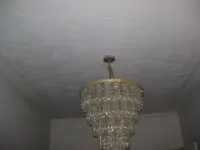nova treasure
Bronze Member
- #1
Thread Owner
We were sharing thoughts on Montana Jim's Voyage of removing popcorn (acoustical) Spray from his Ceiling. It is interesting How many different designs there is on Ceilings all over the World. I have been in the Drywall Business for over 25 Years and have worked in all Styles of Homes and Businesses and tryed Everything Possible with Drywall known to me in my Part of the Country. I thought I would Share a few designs that I have in my Home and hope others might Share some.
The first Pic is what we call Coin Swirl, the Second Pic is what We call a Sea Shell design.
Nova Treasure
The first Pic is what we call Coin Swirl, the Second Pic is what We call a Sea Shell design.
Nova Treasure







